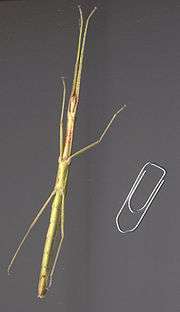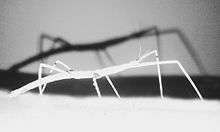Carausius morosus
Carausius morosus[1] (the 'common', 'Indian' or 'laboratory' stick insect) is a species of Phasmatodea (phasmid) often kept as pets by schools and individuals. Culture stocks originate from a collection from Tamil Nadu, India. Like the majority of the Phasmatodea, C. morosus are nocturnal. Culture stocks are parthenogenetic females that can reproduce without mating. There are no reports of males, although in captivity, gynandromorphs (individuals with both female and male characteristics) are sometimes reared.
| Carausius morosus | |
|---|---|
 | |
| Carausius morosus from India | |
| Scientific classification | |
| Kingdom: | Animalia |
| Phylum: | Arthropoda |
| Class: | Insecta |
| Order: | Phasmatodea |
| Infraorder: | Anareolatae |
| Family: | Lonchodidae |
| Subfamily: | Lonchodinae |
| Genus: | Carausius |
| Species: | C. morosus |
| Binomial name | |
| Carausius morosus Sinety, 1901 | |
| Synonyms | |
|
Dixippus morosus Sinéty, 1901[1] | |

Description
Females are elongated and about 80–100 mm in length, ranging from a light green to a darkish brown in colour. The front legs have red patches at the base of the forelegs, and similar but yellow patches on the mid-legs. Eggs are ovoid and brown, with a beige capitula at one end. When the eggs hatch, the plug opens and dark, tiny, string-like young crawl out of the opening. The eggs are haploid.
Behaviour
When disturbed, the major defence method is feigning death, the body becoming rigid, and the legs held along the line of the body. They may also be found swaying to mimic the movement of foliage in wind.
The insects feed at night, when they are active. During the day, they rest, often with legs in line with the body, on their food plants.
Care in captivity
C. morosus is easy species to rear, feeding on a number of fresh plants including privet, ivy, spiderwort, bramble, rowan, and lettuce. They must be kept in a cage around 25 cm in height to allow for successful moulting. Females lay eggs shortly after reaching adulthood, at the rate of several per night. These can be hatched by keeping them on a dry paper towel or in a dry dish. Eggs can take four months to hatch, depending on many factors, including temperature. C. morusus is species #1 on the Phasmid Study Group Culture List.
Accidental introductions

Due to their inconspicuous nature, accidental introductions of C. morosus have been recorded around the world, including South Africa, Great Britain and the United States, where in some cases they have become a pest.[2] Studies at San Diego Zoo found the introduced species on a large number of ornamental plants.[3]
References
- Roskov Y.; Kunze T.; Orrell T.; Abucay L.; Paglinawan L.; Culham A.; Bailly N.; Kirk P.; Bourgoin T.; Baillargeon G.; Decock W.; De Wever A. (2011). Didžiulis V. (ed.). "Species 2000 & ITIS Catalogue of Life: 2011 Annual Checklist". Species 2000: Reading, UK. Retrieved 24 September 2012.
- Baker, E. (2015). "The worldwide status of stick insects (Insecta: Phasmida) as pests of agriculture and forestry, with a generalised theory of phasmid outbreaks" (PDF). Agriculture and Food Security. 4 (22). doi:10.1186/s40066-015-0040-6.
- Baker, E. (2015). "Carausius morosus in San Diego". Figshare (Data Set). doi:10.6084/m9.figshare.1304202.
External links
| Wikimedia Commons has media related to Carausius morosus. |